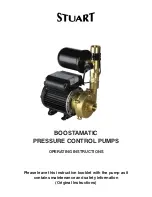
T H E S M A R T S O L U T I O N F O R E N E R G Y E F F I C I E N C Y
Vertical DOAS
R e v. : 0 1 / 3 1 / 1 3
29
c l i m a t e m a s t e r . c o m
System Operation Modes
Principle of Operation - Tranquility DOAS Units -
The
Tranquility DOAS unit conditions 100% outdoor air. Its
refrigeration system extracts heat from, or rejects heat
into a building loop or geothermal loop to maintain
either the supply air or the space temperature. Its mode
of operation depends on whether the outdoor air is
above or below design conditions. A factory-installed
temperature sensor and a relative humidity sensor allow
the controller to dehumidify outdoor air if it is too humid
(usually above a 55°F dewpoint).
Humid Outdoor Air -
When there is a demand for
outdoor air and the air is above the design setpoint,
the refrigeration circuit is activated. The multiple-row
evaporator removes excess moisture from the airstream.
A portion of the energy absorbed by the evaporating
refrigerant is directed to a reheat condenser inside of the
DOAS unit, which then reheats the dried airstream.
Dry Outdoor Air -
When there is a demand for
outdoor air and that air is below the design setpoint,
the refrigeration circuit of the Tranquility is deactivated.
If the system is equipped with an auxiliary heating coil
(optional), it will turn on to heat the outdoor air to the
desired temperature.
The Tranquility DOAS will energize its compressors to
extract energy from a building loop or geothermal loop.
The system will divert this energy to
its hot gas reheat coil to heat the outdoor air to the
desired temperature.
Temperature Control Strategies - There are three
temperature control strategies available on the Tranquility
makeup air DOAS units. Those standard control
sequences include:
•
LAT Control –
The temp sensor is mounted in the
supply duct. The DOAS unit will maintain a constant
supply air temperature setpoint.
•
Room Reset of LAT –
Temperature sensors are
mounted in both the conditioned space and the
supply duct. The unit will maintain a constant
discharge air temperature setpoint. However, the
LAT setpoint is automatically set higher or lower
depending on whether the conditioned space needs
heating or cooling.
•
Unoccupied Temperature and/or Humidity Control
-
A space mounted temperature and/or relative
humidity and damper box sensor is required. During
the unoccupied mode, the compressors will be cycled
on if space heating or cooling is required, or if the
space RH exceeds the setpoint.
Controller Setpoints -
To avoid ongoing controller
adjustments, adjust your setpoints accurately. It takes time
for the unit to establish equilibrium at a given setpoint.
Therefore, continued setpoint adjustments may lead to
higher energy consumption and user discomfort.
Leaving Air Temperature Control Option (LAT) -
Adjustments to the supply temperature can be made with
the user interface or over a DDC network. The controller
will send a signal to the auxiliary heater (where applicable)
to accurately maintain the supply air temperature during
the winter months. In the summer, when the mechanical
dehumidifi cation is active, the controller maintains the
leaving air temperature by modulating the fl ow of hot
refrigerant to the hot gas reheat coil.
Tranquility systems equipped with this option are
provided with a supply air temperature sensor and a
duct-mounted sensor holder. See the holder cut sheet
for assembly and installation details. Mount the sensor at
least fi ve feet downstream from the supply blower. Do not
mount the sensor where it can “see” the auxiliary heater,
since the radiation from the surface of the heater can
affect the sensor’s accuracy.
Room Reset of Leaving Air Temperature Control
Option (RRLAT) -
In this sequence, the controller will
send a signal to the auxiliary heater (where applicable)
to accurately reset the supply air temperature based on
the deviation of the space temperature from its setpoint
during the winter months. In the summer, when the
mechanical dehumidifi cation is active, the controller
resets the supply air temperature to meet the needs of
the space by modulating the fl ow of hot refrigerant to the
hot gas reheat coil.
















































